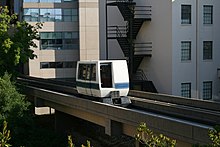Air track (traffic)

An air track is a hovercraft that floats on or in special tracks .
An air track with linear motors has proven itself over many years in local transport at the University Hospital of Duke University in North Carolina .
technology
The air track does not run on wheels, but glides on an air cushion under the cabin like an airboat . The overpressure under the air apron lifts the web off the ground. A rigid cable , linear motor or jet engine drives the cabin on its air cushion via a guide rail along the route. Magnetic levitation trains work similarly, only with magnetic repulsion, but they can use their magnets for both lifting and propulsion. The air-cushion track, on the other hand, requires an additional source of propulsion, usually cable pulls or powered rubber wheels, which are mounted horizontally and travel down the concrete rail. The air cushion track moves with very little vibration as there is no contact with the floor. This increases the comfort for the passengers.
The energy required for operation is significantly lower than with conventional rail systems because there is no contact friction. This also results in significantly less wear on components. Due to its construction, however, the track is only suitable for plane, i.e. H. straight stretches without significant inclines and declines.
The Aérotrain , which was powered by two Pratt & Whitney aircraft turbines and supplied with air for the air cushions, should be mentioned as the forefather of today's air track systems . However, due to the high noise level and other problems, the project was discontinued. The last run of the Aérotrain I-80 took place on December 27, 1977.
history
The first known hovercraft is the French Aérotrain , which was tested from 1965. It was a runway guided on an inverted T-shaped concrete rail with recoil drive (initially by propellers, for testing purposes by rocket motors, later by jet engines ). After the oil crisis, this system was to be equipped with a linear motor drive (around the same time the numerous concepts for gas turbine - powered high-speed trains were abandoned), but development was abandoned in favor of the TGV .
Around 1960, researchers from General Motors noticed the low energy consumption of air cushions on paved roads and developed the Hovair air track with linear motors, which ran on a test track in Denver from 1969 . Because of antitrust law , the General Motors division became Transportation Technology Incorporated , which was merged into the Otis Elevator Company in 1971. The manufacturer of elevator systems turned air cushion tracks into cable trays .
By 1973 the British prototype RTV 31 drove an air track with linear motors and reached speeds of up to 100 miles per hour .
As part of the development of the German magnetic levitation train , the Transrapid , a test vehicle ( Transrapid 03 ) was created, which was a linear motor-driven air-cushion suspension train. After negative comparative tests with the Transrapid 02 , the concept was not pursued any further.
A 1.28 km long air suspension ropeway was built in 1985 in the winter sports resort of Serfaus in Tyrol . The Serfaus village railway is driven by a rope running to the side. Another hovercraft is the Skymetro at Zurich Airport , which is also powered by ropes and connects the old airport building with the new apron terminal E (Midfield) over a length of 1,138 m.
Individual evidence
- ^ Duke University Medical Center PRT Modernization Study. Jakes Associates Inc., accessed November 7, 2014 .
- ^ SPIEGEL ONLINE, Hamburg Germany: Monster on rails: The draft - SPIEGEL ONLINE - one day. Retrieved June 26, 2017 .
- ^ J. Edward Anderson: Some Lessons from the History of Personal Rapid Transit (PRT). University of Washington , August 4, 1996, accessed November 7, 2014 .
- ↑ Professor Eric Laithwaite & the RTV31 Linear Motor Hover Train project in 1973. (No longer available online.) Imperial College London , November 1, 2012, archived from the original on November 7, 2014 ; Retrieved November 7, 2014 . Info: The archive link was inserted automatically and has not yet been checked. Please check the original and archive link according to the instructions and then remove this notice.


